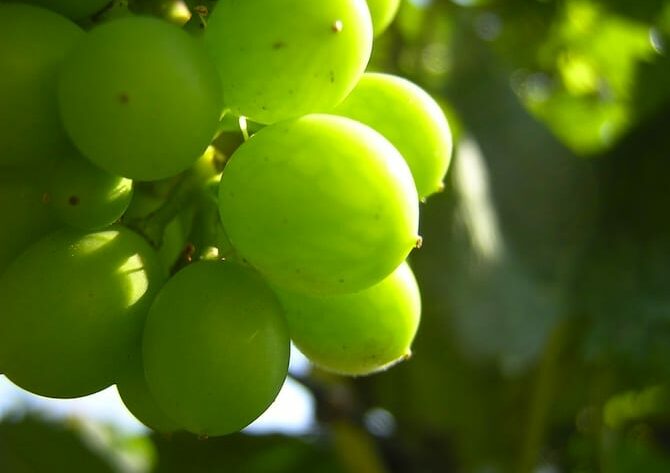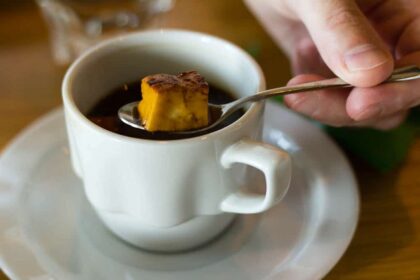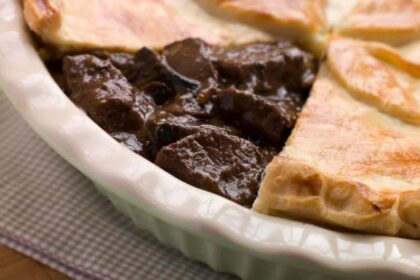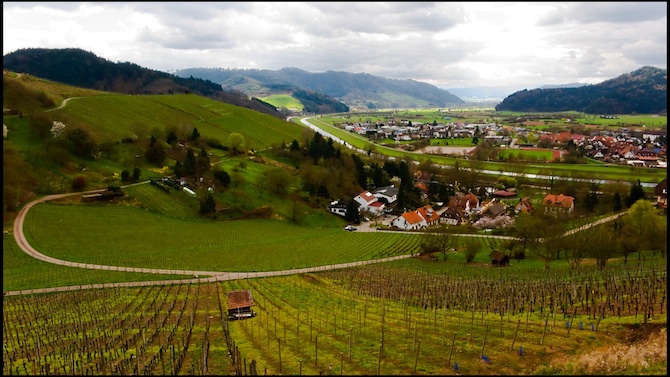
For those who have been following along with Epicure & Culture’s Sommelier Certification series, you’ll know for the past few weeks I’ve been exploring the offerings of France’s top wine regions withe Sommelier Society of America. In our last class, we finally traveled to another country: Germany.
This class was taught by Rudi Eilers, a German-born wine expert and a Sommelier Society of America certification holder. He started off by asking the class what came to mind when they thought of German wines to help us start making a list of characteristics one can relate to the region. One thing he absolutely wanted us to eliminate from our minds was the idea German wines were all sweet.
“German wines are not all sweet, just like not all Rieslings are sweet,” he said. “One thing you can always expect from a Riesling is flavor and aromatics. They’re never dull.”
Germany is a cool climate wine region, so far north it’s a miracle they can even produce wine. Luckily, the wine regions are located never rivers, which moderate the climate. Moreover, as 80% of Germany’s vineyards are on hills the sunlight can reflect off these rivers like mirrors and help cultivate the vines. As Germany is a cool climate, one can typically expect high acid, freshness, fruitiness and low alcohol (about 8-12%) wines. Whether the wine is sweet or not depends on the winemaker and how long they decide to leave the grapes on the vine, how long they allow fermentation to go on for and if they use any enhancements, for example, suisse reserve, where the winemaker adds unfermented grape juice into fermented wine to boost the sweetness.
In Germany, there are 13 wine regions and 40 districts, or bereiche. From there you get into grosslage, or collective vineyard sites, and einzellage, single vineyard sites. These single vineyards sites can be combined to create a grosslage, with these wines being able to source grapes from several vineyards. Germany is home to 2,715 individual vineyard sites. Typically, einzellage denotes a higher quality wine, as, like in Bordeaux, the smaller you go in terms of production the better the wine.
German wines are classified even further through the country’s 1971 wine laws beginning with Tafelwein (table wine) then moving on to Landwein (special regional wine), Qualitatswein (quality wine, also known as “QbA”) and, the most esteemed wines, Pradikatswein (quality wine with special attributes, also known as “QmP”). For the most part — specifically 95-98% — German wines fall under the quality wine category, meaning they must be made from approved grapes in one of 13 specified growing regions. These include Mosel-Saar-Ruwer, Rheingau, Rheinhessen, the Pfalz (formerly Rheinpfalz), Mittelrhein, Baden, Nahe, Franken, Saale-Unstrut, Ahr, Sachsen, Württemberg and Hessische Bergstraße. They’re also allowed to use chaptalization, a technique where sugar is added to grape juice before fermentation to add higher alcohol and body (not sweetness).
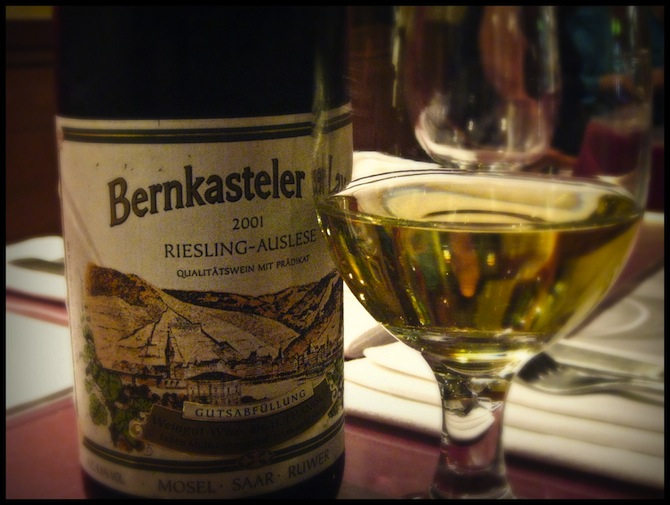
When you move up to Pradikatswein things get even more strict and a bit more complicated. The same rules apply as with quality wine — although chaptalization is no longer allowed — however, now there is a major focus on grape ripeness. Keep in mind, ripeness is the measure of the sugar is a grape before fermentation, while sweetness looks at residual sugar after fermentation. Ripeness of grapes is measured in Oechsle, and, according to Mr. Eilers, goes from least ripe to ripest like this:
- Kabinett: A light, low-alcohol wine made from fully-ripened grapes measuring 67 to 82 degrees Oe. For this grapes are picked during the usual harvest. Typically these wines are drank young, and impart just a touch of sweetness.
- Spätlese: Spätlese means “late harvest,” as, compared to Kabinett, they’re picked late at 76 to 90 degrees Oe. They can be made dry or have some sweetness, although the high acidity usually lessens this.
- Auslese: This translates to “selected harvest.” These grapes are picked at 83 to 100 Oe, and many times are slightly affected by botrytis. These wines are typically delicious when aged, with some of the sweetness falling away and the aromas and flavors becoming more complex.
- Beerenauslese: Called “BA” for short and meaning “berry selected harvest,” Beerenauslese grapes are overly ripes and individually selected at 110 to 128 Oe. Typically these grapes have been affected by botrytis, so will be used for dessert wines with a rich honeyed characteristic.
- Eiswein: Translated to “ice wine,” these grapes are also picked at 110 to 128 Oe; however, they are frozen when harvested and vinified. These sugars, acidity and flavors are very concentrated, allowing for an intensely acidic and sweet wine at the same time.
- Trockenbeerenauslese: Also known as “TBA” and translated to “dry beer selected harvest,” these grapes are raisin-like at the time of picking — affected by botrytis — and measure 150 to 154 Oe. Because of their richness and rarity these wines are the most expensive German wines you’ll find. Note that because of their high sugar concentration the yeast has a hard time fermenting it all, leaving the wine with only 6% alcohol.
Of course, the more ripe you get on the scale the rarer the grapes become, as Germany’s cool climate makes ripe grapes hard to achieve. That’s not to say Germany doesn’t make sweet wines from ripe grapes. Simply read the above Pradikatswein ripeness table to see how sweet these grapes can get. In fact, because of its cool climate that leads to bright, lively, high acid wines, they’re able to produce sweet wines that don’t taste syrupy, as the acidity cuts the perceived sugar.

Sweetness
The important thing to remember when reading the above categorizations is, again, that they are not referring to sweetness, but ripeness. If you want to know how sweet a German wine is you’ll need to look at an entirely different set of categories, which, according to Mr. Eilers go:
- Trocken: Dry wine that sometimes has noticeably high level of acidity or tannin with a maximum of 9 grams per liter (g/l) residual sugar
- Halbtrocken: Half-dry wine with a maximum of 18 g/l of residual sugar. Because German wines are high in acidity they often taste drier than they really are.
- Feinherb: An off-dry wine that’s a touch sweeter than halbtrocken, but is unregulated
- Lieblich: A word meaning “lovely,” this is a semi-sweet wine with a maximum of 45 g/l residual sugar
- Edelsuss: A sweet wine with more than 45 g/l residual sugar
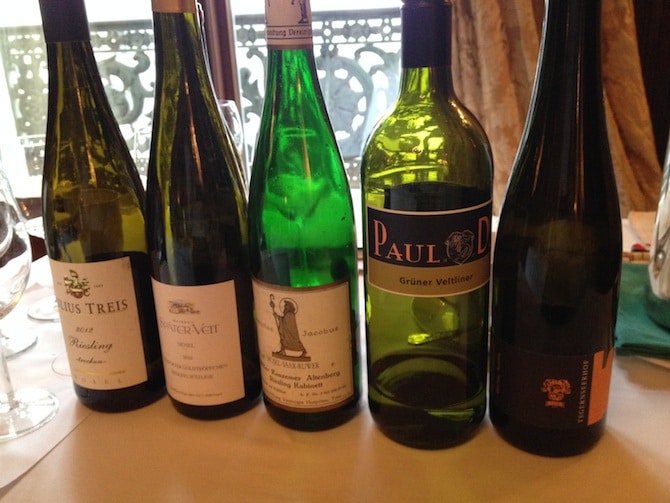
White…And Red?
Something that may surprise many people is that Germany produces both whites and reds. Along with Riesling, the country’s white grapes include Gewürztraminer, Müller-Thurgau, Rieslaner, Ruländer (Pinot Gris), Scheurebe, Silvaner and Weissburgunder (Pinot Blanc). They also produce a sparking white Sekt and a red Spatburgunder, a typically light, earthy wine. Other red grapes include Blauer Portugieser (light and acidic), Dornfelder (fruity and good acidity) and Trollinger (light and slightly sweet).
Additionally, you may find it surprising that while Riesling is the prize of Germany, it’s not the most popularly planted. That would be Müller-Thurgau, which, while once believed to be a cross between Riesling and Silvaner, it’s actually Riesling and Madeleine Royale. Müller-Thurgau is a high yielding grape that’s often described as refreshing with good minerality; however, without being crossed it’s usually dull and flat, at least in Germany. Crossings like this came about as Riesling is a fragile grape. Winemakers wanted to keep its positive characteristics like its intense aromatics and flavor while also allowing for earlier ripening. This also allowed for experimenting with how its characteristics worked with those of other grapes.
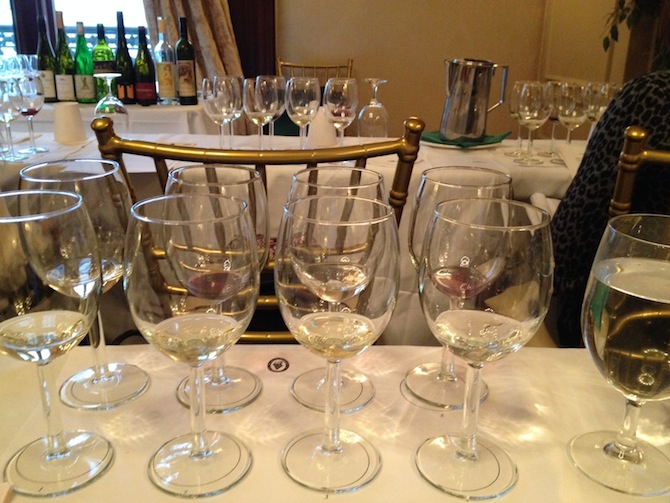
The Tasting
As the Germany class was combined with the Austria class — more to come on that in our next edition — we sampled three German wines, all from the Mosel region. Interestingly, Mosel is the coolest of Germany’s wine regions, and is known for its bright acidity and autumn fruit essence.
The first wine we sampled was a 2012 Julius Treis Riesling QbA Trocken. While above I discussed the ripeness pyramid, this wine actually was not ripe enough to even be called Kabinett, the least ripe of the fully ripened Pradikatswein attributes. That doesn’t mean it wasn’t worthwhile, especially for $20 a bottle. On the nose there was a lot of lemon, apple and pear, while on the palate I got high acidity and some steel.
This was much different from our next wine, despite being from the same region and being made with the same grape. It was a “Spater-Veit Piesporter Goldtropfchen Riesling Spatlese ($19). The variation was from the much riper grapes, with tropical fruits on the nose and the rounder palate. It was sweeter, less acidic and almost honeyed. It’s worth noting the 8% alcohol content, as low alcohol means more residual sugar, leading to sweeter wines.
Lastly, a very special 1985 Vereinigte Hospitien Kanzemer Altenberg Riesling Kabinett allowed us to try an aged German wine. The candied lemon on the nose was indicative of the age. The wine still had an impressively bright acidity and offered a sumptuous lemon cream on the palate. Fun fact: this wine comes from the oldest wine cellar in Germany, part of which was built by the ancient Romans.
Have you explored Germany’s wine regions or sampled a German wine you really enjoyed? Please share in the comments below.
Also Check Out:
Sommelier Certification: How To Truly Appreciate (And Understand) Champagne
Do You Want To Make Money Traveling The World?
Northern And Southern Rhone: Two Very Different Wine Worlds
Jessica Festa
Latest posts by Jessica Festa (see all)
- A Culturally-Immersive Adventure In Mongolia’s Altai Mountains - Jul 8, 2023
- This Recipe Sharing Platform Supports Women In The Culinary Industry (Labneh Recipe Included!) - Nov 5, 2020
- Hiking The Mohare Danda Community Eco-Trek In Nepal - Jun 3, 2020
- 6 Important Questions For Choosing A Responsible Yoga Retreat - May 18, 2020
- How To Create & Grow A Profitable Blogging Business (Ethically) - Jan 18, 2020

